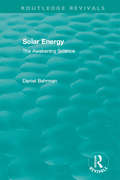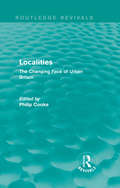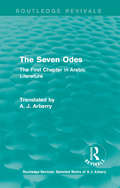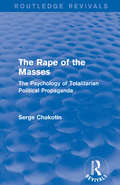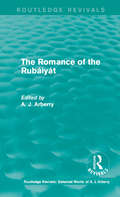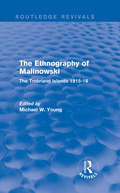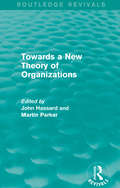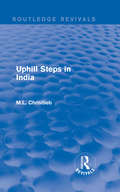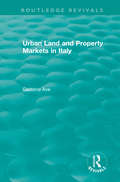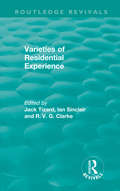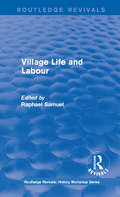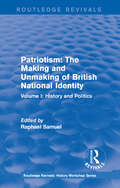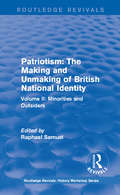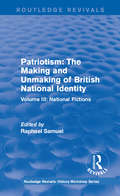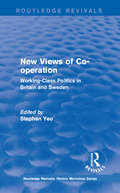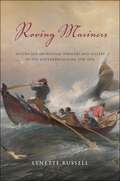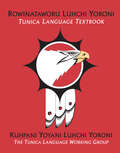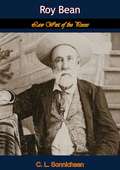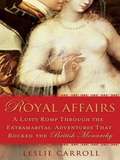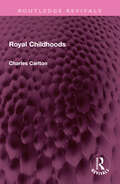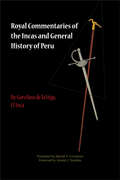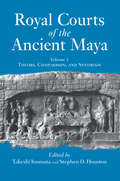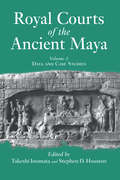- Table View
- List View
Routledge Revivals: The Awakening Science (Routledge Revivals)
by Daniel BehrmanOriginally published in 1979, Solar Energy provides a tour of the world of solar energy and asks two key questions: is solar energy the key to the future of our energy needs, and what are the facts and potential of this source of renewable power. The book examines solar energy from the past, to modern plans for designing domestic solar housing, and looks at the sites and the technology applied to harness the Sun's power, such as the energy potential of windmills and the equatorial oceans. Behrman reports on the progress of scientists and manufacturers in making solar energy a viable competitor in the energy market, and studies the projections of a future energy crop for energy plantations.
Routledge Revivals: The Changing Face of Urban Britain (Routledge Library Editions: Social Theory Ser.)
by Philip CookeFirst published in 1989, this book examines seven different localities, ranging from the outer suburbs of large northern cities to small freestanding town, which were prospering in the 1980s or struggling against the negative employment effects of restructuring. Within the theoretical frame of ‘industrial restructuring’, it traces the development of each locality, exploring in depth the influence of several key elements — deindustrialisation, technological change, the shift to the services in employment — on social composition, political change and local policy. A major contribution to locality studies, this book is essential reading for students of urban and regional studies, and sociology.
Routledge Revivals: The First Chapter in Arabic Literature (Routledge Revivals: Selected Works of A. J. Arberry #2)
by A. J. ArberryThese seven poems, translated by A. J. Arberry in 1957, are the most famous survivors of a vast mass of poetry produced in the Arabian Desert in the sixth century. Arberry’s introduction explains to the reader what was known about the poems and how they came to be preserved and distributed over time. The epilogue particularly interrogates the authenticity of the poems and tracks how they have been transmitted over time. This work will be of interest to those studying Persian and Middle-Eastern literature and history.
Routledge Revivals: The Psychology of Totalitarian Political Propaganda (Routledge Revivals)
by Serge ChakotinFirst published in French in 1939, and later in English in 1940, this work by the author, analyses and strongly critiques the effect of Nazi propaganda on the psychology of the masses. By bringing together the political and the psychological, the author refers to the use of propaganda in order to serve the ends of a handful of men as ‘psychical rape’ and warns that this phenomenon cannot be attributed solely to the Nazi regime. The English translation was updated to account for the outbreak of the Second World War in 1939. It will be of great interest to anyone studying the Second World War, Nazism, Fascism and the psychology of propaganda.
Routledge Revivals: The Romance of the Rubáiyát (Routledge Revivals: Selected Works of A. J. Arberry)
by A. J. ArberryFirst published in 1959, this reprint of the first edition of Edward FitzGerald’s translation of the Rubáiyát is accompanied by an introduction and notes by A J Arberry, one of Britain’s most distinguished Orientalist scholars. The Rubáiyát is a selection of poems written in Persian attributed to Omar Khayyám. The work will be of interest to those studying Middle Eastern Literature.
Routledge Revivals: The Trobriand Islands 1915-18 (Routledge Revivals)
by Michael W. YoungBronislaw Malinowski is one of the founding fathers of modern social anthropology and the innovator of the technique of prolonged and intensive fieldwork. His writings about the Trobriand Islands of Papua were in their time the most formative influence on the work of British social anthropologists and are of perennial interest and importance. They produced a revolution in the aims and field techniques of social anthropologists, and the method he created is that now normally used by anthropologists in the field. Malinowski’s field material remains compulsory reading for students. First published in 1979, this book draws from the major monographs of Malinowski to compile a selection of his writings on the Trobriand Islanders. In presenting a concise Trobriand ethnography in one volume, the author gives balanced coverage of economic life, kinship, marriage and land tenure, and to the system of ceremonial exchange known as the Kula. He also provides, in an introductory essay, a critical assessment of Malinowski the ethnographer, and gives a brief account of the Trobriands in a modern perspective.
Routledge Revivals: Towards a New Theory of Organizations (1994)
by Martin Parker John HassardFirst published in 1994, the essays collected in this book explore the impact and current status of the ideas put forth in David Silverman’s The Theory of Organizations, and how they relate to future directions in organization theory. After opening with a chapter by Silverman himself, the subsequent chapters investigate key issues in the study of organizations, including structure and agency, the politics of organization theory, and the meanings of post-positivist organizational analysis. Contemporaneous debates on postmodernism, the emotions, gender and structuration are discussed in the context of the development of organizational theory in the preceding twenty-five years — providing insights into the continuities within organizational theory and provoking thought about future directions.
Routledge Revivals: Uphill Steps in India (1930)
by M.L. ChristliebFirst published in 1930, the author asserts that this book presents a human India ‘in all sorts of conditions and moods’. It details her first-hand experiences as a female missionary in India over the course of thirty-three years in India along with some further accounts related by eyewitnesses. It avoids proposing theories of giving abstract general pronouncements but instead focuses on the individual people with the intention that it would promote greater understanding of the nation by westerners. This book will be of interest to students of Indian, colonial and women’s history.
Routledge Revivals: Urban Land and Property Markets in Italy (Routledge Revivals)
by Gastone AveOriginally published in 1996, Urban Land and Property Markets describes the intricacies of the Italian urban planning system, and the interconnections between the property sector, the national economy, and recent historical developments, including the new challenges facing Italy after the early 1990s collapse of the party system. The book’s underlying thesis is that property values are ultimately created by urban planning and investment in infrastructure. Negotiations between local government and developers focus on three basic issues: the ultimate use of urban land, the quantitative control of development via planning permissions relating to city master plans, and the nature of public investment to support growth and property values.
Routledge Revivals: Varieties Of Residential Experience (1975) (Routledge Revivals)
by Ian Sinclair Jack Tizard R.V.G. ClarkeFirst published in 1975, this book compiles a number of studies concerning institutional care and children, which address the question of why institutions that serve apparently similar functions differ so much. The book uses comparative methods such as measurement of different ‘dimensions’ of institutional care and analysis of interrelationships among specific structural and functional features which characterise particular institutions. As a result, the book draws broad conclusions about the importance of factors that have dynamic influence on the manner in which institutions function and the reasons why they differ. The editors reject the ‘steampress’ model which postulates that institutions are more or less alike. They discuss ideological and organisational variation, differences in staffing and the manner in which children respond to them, and consider these issues as factors that influence the way in which an institution functions ‘as a whole’. Subsequent chapters describe comparative studies carried out in institutions for the mentally handicapped, approved schools, residential nurseries, probation hostels, other ‘correctional’ institutions and units for autistic children. The book enables the reader to appreciate achievements and shortcomings of contemporary research and thinking in this field.
Routledge Revivals: Village Life and Labour (Routledge Revivals: History Workshop Series)
by Raphael SamuelFirst published in 1975, this volume aims to direct attention at a number of aspects of the lives and occupations of village labourers in the nineteenth-century that have been little examined by historians outside of agriculture. Some of the factors examined include the labourer’s gender, whether they lived in ‘closed’ or ‘open’ villages and what they worked at during the different seasons of the year. The author examines a range of occupations that have previously been ignored as too local to show up in national statistics or too short-lived to rank as occupations at all as well as sources of ‘secondary’ income. The analysis of all of these factors in related to the seasonal cycle of field labour and harvests. The central focus is on the cottage economy and the manifold contrivances by which labouring families attempted to keep themselves afloat.
Routledge Revivals: Volume I: History and Politics (Routledge Revivals: History Workshop Series)
by Raphael SamuelFirst published in 1989, this is the first of three volumes exploring the changing notions of patriotism in British life from the thirteenth century to the late twentieth century and constitutes an attempt to come to terms with the power of the national idea through a historically informed critique. This volume deals with the role of politics, history, religion, imperialism and race in the formation of English nationalism. In chapters dealing with a wide range of topics, the contributors demystify the prevailing conceptions of nationalism, suggesting ‘the nation’ has always been a contested idea, and only one of a number of competing images of collectivity.
Routledge Revivals: Volume II: Minorities and Outsiders (Routledge Revivals: History Workshop Series)
by Raphael SamuelFirst published in 1989, this is the second of three volumes exploring the changing notions of patriotism in British life from the thirteenth century to the late twentieth century and constitutes an attempt to come to terms with the power of the national idea through a historically informed critique. This volume examines how national identity has competed with alternative, more personal forms of belonging — such as Roman Catholicism, Judaism and Nonconformism — as well looking at femininity in relation to the state. Contemporary British society’s capacity to create outsiders is discussed and the introductory essay shows how this may shape our misunderstanding of earlier phases of national development.
Routledge Revivals: Volume III: National Fictions (Routledge Revivals: History Workshop Series)
by Raphael SamuelFirst published in 1989, this is the third of three volumes exploring the changing notions of patriotism in British life from the thirteenth century to the late twentieth century and constitutes an attempt to come to terms with the power of the national idea through a historically informed critique. This volume studies some of the leading figures of national myth, such as Britannia and John Bull. One group of essays looks at the idea of distinctively national landscape and the ways in which it corresponds to notions of social order. A chapter on the poetry of Edmund Spenser explores metaphorical representations of Britain as a walled garden, and the idea of an enchanted national space is taken up in a series of essays on literature, theatre and cinema. An introductory piece charts some of the startling changes in the image of national character, from the seventeenth-century notion of the English as the most melancholy people in Europe, to the more uncertain and conflicting images of today.
Routledge Revivals: Working-Class Politics in Britain and Sweden (Routledge Revivals: History Workshop Series #9)
by Stephen YeoFirst published in 1988, this book sets out to reinterpret the changing place of working-class association in capitalist Britain. It argues that in combination, co-operation and association constitutes labour’s power — what is has to work with and who to work for — yet social historians have tended to overlook such views in a co-operative setting. What was the struggle, what form did it take, who were the protagonists and what relevance did they have to the community co-operators of the 1980s? The essays collected in this book explore class potential and class conflict within and against co-operative thought and practice.
Roving Mariners: Australian Aboriginal Whalers and Sealers in the Southern Oceans, 1790–1870 (SUNY series, Tribal Worlds: Critical Studies in American Indian Nation Building)
by Lynette RussellFor most Australian Aboriginal people, the impact of colonialism was blunt—dispossession, dislocation, disease, murder, and missionization. Yet there is another story of Australian history that has remained untold, a story of enterprise and entrepreneurship, of Aboriginal people seizing the opportunity to profit from life at sea as whalers and sealers. In some cases participation was voluntary; in others it was more invidious and involved kidnapping and trade in women. In many cases, the individuals maintained and exercised a degree of personal autonomy and agency within their new circumstances. This book explores some of their lives and adventures by analyzing archival records of maritime industry, captains' logs, ships' records, and the journals of the sailors themselves, among other artifacts. Much of what is known about this period comes from the writings of Herman Melville, and in this book Melville's whaling novels act as a prism through which relations aboard ships are understood. Drawing on both history and literature, Roving Mariners provides a comprehensive history of Australian Aboriginal whaling and sealing.
Rowinataworu Luhchi Yoroni / Tunica Language Textbook
by Kuhpani Yoyani Luhchi Yoroni / The Tunica Language Working GroupThe essential guide for learning the Tunica language.For many years, the Tunica-Biloxi Tribe of Louisiana collaborated with students and faculty at Tulane University on a project to revitalize the Tunica language. Tunica had not been spoken or used regularly in the community since the last known speaker, Sesostrie Youchigant, passed away in 1948. The center of the revitalization of the Tunica language is this first-of-its-kind, beginning Tunica language textbook.The Tunica Language Textbook (Rowinataworu Luhchi Yoroni) contains everything needed to become conversationally fluent in Tunica. Like other language textbooks, it contains vocabulary and grammatical information, as well as practice exercises that develop both comprehension and production of Tunica, and acquisition of the patterns, not just the forms. The textbook contains links to an online pronunciation guide and includes a wealth of information on cultural topics, from stickball to basketry to naming to cosmology, and uses the language to do so. Wherever possible, excerpts from the original documentation of Tunica stories and myths have been included, so that students can become acquainted with native-like language use.Each chapter is structured to lead the student through the stages of learning, from presentation of new information, to recognition, to identification, to application. While there is explanation of the topics in English, the lessons are designed to be used in an immersion classroom setting as well as for individual use.
Roxanne Dunbar-Ortiz's Indigenous Peoples' History of the United States: A Graphic Interpretation (ReVisioning History #8)
by Paul Peart-SmithIn stunning full color and accessible text, a graphic adaptation of the American Book Award winning history of the United States as told from the perspective of Indigenous peoples—perfect for readers of all agesRoxanne Dunbar-Ortiz&’s influential New York Times bestseller exposed the brutality of this nation&’s founding and its legacy of settler-colonialism and genocide. Through evocative full color artwork, renowned cartoonist Paul Peart-Smith brings this watershed book to life, centering the perspective of the peoples displaced by Europeans and their white descendants to trace Indigenous perseverance over four centuries against policies intended to obliterate them.Recognized for his adaptation of W.E.B. DuBois&’ The Souls of Black Folk and his extensive expertise in the comics industry, Peart-Smith collaborates with experienced graphic novel editor Paul Buhle to provide an accessible introduction to a complex history that will attract new generations of readers of all ages. This striking graphic adaptation will rekindle crucial conversations about the centuries-long genocidal program of the US settler-colonial regime that has largely been omitted from history.
Roy Bean: Law West of the Pecos
by C. L. SonnichsenPhantly Roy Bean, Jr. (1825-1903), self-styled “Law West of the Pecos,” was an eccentric American saloon-keeper and Justice of the Peace in Val Verde County, Texas. According to legend, he held court in his saloon along the Rio Grande on a desolate stretch of the Chihuahuan Desert of southwest Texas.Southwestern historian and folklorist, C. L. Sonnichsen, lived near Judge Bean’s house for several years and decided to pen this biography, first published in 1943, owing to his belief that it was “high time for somebody to look into his history and see how a Roy Bean ever came to be at all.” Roy Bean: Law West of the Pecos examines Judge Bean’s legendary, as well as factual background and makes for a fascinating read.
Royal Affairs
by Leslie CarrollA funny, raucous, and delightfully dirty history of 1,000 years of bedroom-hopping secrets and scandals of Britain?s royals. Insatiable kings, lecherous queens, kissing cousins, and wanton consorts?history has never been so much fun. Royal unions have always been the stuff of scintillating gossip, from the passionate Plantagenets to Henry VIII?s alarming head count of wives and mistresses, to the Sapphic crushes of Mary and Anne Stuart right on up through the scandal-blighted coupling of Prince Charles and Princess Diana. Thrown into loveless, arranged marriages for political and economic gain, many royals were driven to indulge their pleasures outside the marital bed, engaging in delicious flirtations, lurid love letters, and rampant sex with voluptuous and willing partners. This nearly pathological lust made for some of the most titillating scandals in Great Britain?s history. Hardly harmless, these affairs have disrupted dynastic alliances, endangered lives, and most of all, fed the salacious curiosity of the public for centuries. Royal Affairs will satiate that curiosity by bringing this arousing history alive. .
Royal Childhoods (Routledge Revivals)
by Charles CarltonFirst published in 1986, Royal Childhoods shows how the early years of Britain’s kings and queen have coloured their later lives. Combining skills of a professional historian with a knowledge of psychology, the author links the study of childhood to known pattern of events. His book makes the distant figures of royalty more comprehensible as individuals. With great insight into the influence of childhood experience, he covers the whole span of British monarchy from William the Conqueror to the Prince of Wales. This book will be of interest to students of history, literature and psychology.
Royal Commentaries of the Incas and General History of Peru, Parts One and Two
by Garcilaso de la VegaThe two-part classic history of the Incan empire&’s origin and growth, as well as their demise following the arrival of the Spaniards.Garcilaso de la Vega, the first native of the New World to attain importance as a writer in the Old, was born in Cuzco in 1539, the illegitimate son of a Spanish cavalier and an Inca princess. Although he was educated as a gentleman of Spain and won an important place in Spanish letters, Garcilaso was fiercely proud of his Indian ancestry and wrote under the name EI Inca.Royal Commentaries of the Incas is the account of the origin, growth, and destruction of the Inca empire, from its legendary birth until the death in 1572 of its last independent ruler. For the material in Part One of Royal Commentaries—the history of the Inca civilization prior to the arrival of the Spaniards—Garcilaso drew upon &“what I often heard as a child from the lips of my mother and her brothers and uncles and other elders . . . [of] the origin of the Inca kings, their greatness, the grandeur of their empire, their deeds and conquests, their government in peace and war, and the laws they ordained so greatly to the advantage of their vassals.&”The conventionalized and formal history of an oral tradition, Royal Commentaries describes the gradual imposition of order and civilization upon a primitive and barbaric world. To this Garcilaso adds facts about the geography and the flora and fauna of the land; the folk practices, religion, and superstitions; the agricultural and the architectural and engineering achievements of the people; and a variety of other information drawn from his rich store of traditional knowledge, personal observation, or speculative philosophy. Important though it is as history, Garcilaso&’s classic is much more: it is also a work of art. Its gracious and graceful style, skillfully translated by Harold V. Livermore, succeeds in bringing to life for the reader a genuine work of literature.
Royal Commentaries of the Incas and General History of Peru, Parts One and Two
by Garcilaso de la VegaThe two-part classic history of the Incan empire&’s origin and growth, as well as their demise following the arrival of the Spaniards.Garcilaso de la Vega, the first native of the New World to attain importance as a writer in the Old, was born in Cuzco in 1539, the illegitimate son of a Spanish cavalier and an Inca princess. Although he was educated as a gentleman of Spain and won an important place in Spanish letters, Garcilaso was fiercely proud of his Indian ancestry and wrote under the name EI Inca.Royal Commentaries of the Incas is the account of the origin, growth, and destruction of the Inca empire, from its legendary birth until the death in 1572 of its last independent ruler. For the material in Part One of Royal Commentaries—the history of the Inca civilization prior to the arrival of the Spaniards—Garcilaso drew upon &“what I often heard as a child from the lips of my mother and her brothers and uncles and other elders . . . [of] the origin of the Inca kings, their greatness, the grandeur of their empire, their deeds and conquests, their government in peace and war, and the laws they ordained so greatly to the advantage of their vassals.&”The conventionalized and formal history of an oral tradition, Royal Commentaries describes the gradual imposition of order and civilization upon a primitive and barbaric world. To this Garcilaso adds facts about the geography and the flora and fauna of the land; the folk practices, religion, and superstitions; the agricultural and the architectural and engineering achievements of the people; and a variety of other information drawn from his rich store of traditional knowledge, personal observation, or speculative philosophy. Important though it is as history, Garcilaso&’s classic is much more: it is also a work of art. Its gracious and graceful style, skillfully translated by Harold V. Livermore, succeeds in bringing to life for the reader a genuine work of literature.
Royal Courts Of The Ancient Maya: Volume 1: Theory, Comparison, And Synthesis
by Takeshi InomataThe two volumes of Royal Courts of the Ancient Maya provide current archaeological perspectives on Maya courts conceived as vital, functioning social groups composed of lords, courtiers, scribes, priests, and entertainers, among many others. In addition to archaeological data on the architecture and other spatial attributes of courts, the studies in the two volumes bring to bear on the topic the most recent evidence from inscriptions, vase paintings, murals and friezes, and ethnohistoric records in order to flesh out a portrait of the actors and roles that made up Maya courts through time and across space. The attributes of courts are explored in the Maya highlands and lowlands, from the origins of early kingship through the Classic period to the Postclassic and Terminal epochs. Pertinent comparisons are also drawn from the Aztecs and other ancient and contemporary societies. Volume 1: Theory, Comparison, and Synthesis establishes a carefully considered framework for approaching the study of courts and their functions throughout the world of the ancient Maya. Volume 2: Data and Case Studies provides authoritatively current data and insights from key Maya sites, including Cop? Tikal, Caracol, Bonampak, and Calakmul.
Royal Courts Of The Ancient Maya: Volume 2: Data And Case Studies
by Takeshi InomataThe two volumes of Royal Courts of the Ancient Maya provide current archaeological perspectives on Maya courts conceived as vital, functioning social groups composed of lords, courtiers, scribes, priests, and entertainers, among many others. In addition to archaeological data on the architecture and other spatial attributes of courts, the studies in the two volumes bring to bear on the topic the most recent evidence from inscriptions, vase paintings, murals and friezes, and ethnohistoric records in order to flesh out a portrait of the actors and roles that made up Maya courts through time and across space. The attributes of courts are explored in the Maya highlands and lowlands, from the origins of early kingship through the Classic period to the Postclassic and Terminal epochs. Pertinent comparisons are also drawn from the Aztecs and other ancient and contemporary societies. Volume 1: Theory, Comparison, and Synthesis establishes a carefully considered framework for approaching the study of courts and their functions throughout the world of the ancient Maya. Volume 2: Data and Case Studies provides authoritatively current data and insights from key Maya sites, including Cop? Tikal, Caracol, Bonampak, and Calakmul.
